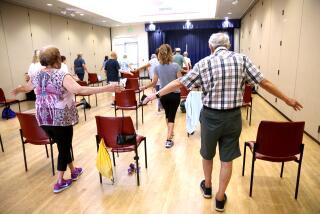Managing Retirement : Careers: After 80-hour workweeks and the trappings of corporate power, many executives find life in the slow lane jarring. Experts say the secret is planning.
Cornell Maier admits that a few times after he retired as chairman of Kaiser Aluminum, he took the wrong elevator and headed for his old executive suite rather than the new office in the same Oakland complex where he now works on public education issues.
Ed Akins allows that it was difficult for him to avoid second-guessing his sons when he began turning his successful Orange County home-building firm over to them.
Former aerospace executive Frank Lynch wanted to continue his nonprofit work, but found some boards were less interested in him than in “the guy from Northrop.”
Gracefully stepping off the corporate ladder can be difficult for those at the top.
While high-level executives usually are more than prepared financially, they frequently neglect the emotional side, job counselors say. Even those who make a successful transition--Maier, Akins and Lynch, among them--have moments when they suspect that they might not be the retiring kind.
Top executives often underestimate how much they will miss the power and the trappings of the job. The limo and the corporate jet disappear. Social lives can dry up; golf games get boring.
“I know very few happy retired people,” Akins said. “It’s tough, first off, from an ego standpoint.”
Some work around the problem by never retiring. And those who do seem to universally hate the “R” word.
“Most of the people we work with don’t like that word--retirement. They like to think they’re in a career change,” said Carl E. Samuels, who, along with his business partner and wife, Keiko Matsuura, specializes in counseling executives who are age 50 or older.
“Most people don’t prepare very well for retirement,” said Richard Knowdell, a San Jose career counselor and executive director of the Career Planning & Adult Development Network, a national network of career counselors. “It’s like heading for a cliff with a blindfold on.”
Top-level retirement was the subject of a 1988 book titled “The Hero’s Farewell: What Happens When CEOs Retire.” In it, author Jeffrey Sonnenfeld, then an associate professor at Harvard Business School, contended that the way a top executive retires has a major effect on the organization that he leaves.
(Even in 1990, top executives of a certain age are still, for the most part, men, particularly in corporations.)
There are four basic departure styles, which Sonnenfeld, now a professor of organization and management at Emory University in Atlanta, labeled monarch, general, ambassador and governor.
Monarchs die in office or are overthrown. Generals also frequently are forced out and then plot a triumphant return. Ambassadors leave but maintain ties with the company. Governors exit the job and seldom look back.
“Some heroes, even in late career, often ride off into the sunset--not to obscurity, but in search of new adventures,” Sonnenfeld wrote. “But to others, retirement suggests an abdication of heroic status and an aborted heroic mission.”
The higher up you go in a hierarchy, the more difficult retirement becomes, said Elwood Chapman, a former university professor who has written several books about retirement planning and other aspects of working life.
“You get that ego fulfillment (from the job), and you can’t get that at the country club or on the golf course,” Chapman said. “It can be as difficult as a mid-life crisis--maybe more so.”
Perhaps one of the most famous and extreme examples of a bad retirement is that of George Eastman, who continued to haunt the corporate offices for years after his 1925 departure from the presidency of Eastman Kodak. In 1932, Eastman committed suicide, leaving a note that read: “To my friends--My work is done, why wait?”
Part of the problem, Matsuura said, is that people are now living longer and retiring younger. They have a lot of life left to live after retirement and no idea how to do it, she said.
“A lot of people lose a sense of purpose. They are driven by sales quotas, and that’s gone. They lose friends or acquaintances. It’s easy to get into a depression.” Matsuura said.
One executive of a medium-sized Orange County company who was also big on the social scene discovered that when he no longer headed that firm “he lost a lot of friends,” Samuels said.
“A lot of people find that, ‘Gee, a lot of these people I’ve been with are only acquaintances,’ ” he said. “The really sad part about a lot of these CEOs is they have no friends--people they can talk to about what they’re really frightened about.”
Lynch, Maier and Akins did not consult specialists as they neared retirement, but they approached the event much as the experts recommend.
Chapman, for example, advises that all workers plan for retirement at least five years in advance, which often makes their final years with the corporation more productive. Chapman also suggests that executives consider leaving in degrees, perhaps by working part time for a while or maintaining ties with the corporation through consulting.
Retirees must plan how to fill their hours or they risk frittering the time away and becoming dissatisfied with that life, he said.
“People don’t realize just how much time they have when they are retired,” Chapman said. “You sleep eight hours and the business of living takes maybe four and there are 12 hours left. They begin to trivialize it. They do things that don’t have any significance.”
Lynch, former Northrop president who retired from the post of vice chairman a little more than a year ago, remained as a director of the aerospace company for another nine months to ease the transition.
Lynch now spends his time as a director of several nonprofit corporations, including the Foundation for the Joffrey Ballet and Ballet Pacifica, a Laguna-based ballet company of which his daughter, Molly, is artistic director.
“I’ve gone from the B-2 to the tutu,” Lynch quipped. Lynch, 68, also works with the Los Angeles Music Center and is chairman of the investment committee for California State University at Los Angeles Foundation.
“I find that very satisfying,” he said of his nonprofit work.
Problems moving out of the executive suite “have to do with how much you’ve become identified with your work and your company,” Lynch said. For him, “this is just another step that must come along.”
Even though Maier’s retirement coincided with a change of company ownership, he has continued as an occasional consultant for Kaiser Aluminum.
Maier said he decided in 1980 that he would retire by age 62 from the only employer he had ever known and would then devote his life to improving the quality of public education. He ultimately delayed his departure by a year when the company became embroiled in a takeover battle, finally retiring on Jan. 1, 1988. Maier reportedly was hard at work the next day in his new office at his customary starting time: 5:45 a.m.
Maier grew up in a poor home without a father, and he said his mother always worked hard and stressed the value of education.
“K-through-12 reform is the No. 1 interest in my life,” said the 65-year-old Maier, a lifelong bachelor who worked for Kaiser Aluminum for 38 years. “Schools in the whole country are in disarray, and California’s are some of the worst.”
Maier has spent a lot of time speaking to groups about SB 1274, a bill to reform the educational system.
Maier is also involved in California Leadership, a nonpartisan group devoted to “getting more women and minorities in the decision-making process in California.” As its first project, the group is tackling the problem of training the state’s multicultural work force for the 21st Century, he said.
Although his current work “certainly is different . . . I think I was so well prepared for it that it wasn’t difficult” to make the transition, Maier said.
For Akins, the change was gradual. He took his time turning over his Orange County home-building firm to his sons, Bruce and Carl.
Over a period of years, Akins reduced his involvement in the firm, coming to the office fewer days a week as his sons redesigned the company, now called Akins Development, and moved the headquarters to Newport Beach from Tustin.
“I started going in less and less and less,” Akins said. Then one day, Akins realized that his sons were running the company.
“About 1983, I stopped going in altogether. It was an easy out,” he said. “I would hate to work 30 years for a company and walk out one day with my last check. That would be a blow.”
Akins said bowing out of the company that he founded with his wife, Priscilla, in 1948, wasn’t always easy.
“Very few people I know can back out and let someone else do it,” Akins, 64, said. “But when you have strong sons, you don’t want to emasculate them.”
When he left the company, Akins turned to his many other interests, including tending a boat and a ranch.
“Carl likes to say that I’m in the maintenance business. I maintain my home, my car, my boat and my ranch,” Akins said with a laugh.
But Akins hasn’t given up home building entirely. He now constructs miniature versions--primarily as gifts, but sometimes for profit--and Priscilla decorates the insides.
“We’ve built a few of what we call custom homes and we’ve built a few tract homes from kits,” he said.
Consultants Samuels and Matsuura said they find that top executives who have trouble with retirement frequently have lost touch with their wives and families, and have forgotten how to have fun in their push for success.
One businessman who came to them had worked 80-hour weeks for 30 years before he leaped into retirement.
“Everyone around him was really concerned about him because he knew nothing but work,” Matsuura said. “He didn’t have a hobby. He was a multimillionaire, but he didn’t enjoy spending money.”
But the story had a happy ending, she said. After much self-examination, the executive adopted a more family-oriented life style and now spends about 30 hours a week doing charity work.
At their Seal Beach company, Business Life Transitions, where they work with both corporate officials and entrepreneurs, the consultants often organize groups of executives who can help each other through retirement. One group activity is a wilderness trek that is part of a larger self-analysis program.
“They have to do a lot of unlearning of things that made them successful in corporations,” Matsuura said.
Added Samuels: “People have trouble letting go of the bar of the trapeze to even find out what’s on the other side.”
Akins, Maier and Lynch agreed that developing interests outside the job is key to retiring well.
“Get involved in community service,” Maier said. “There’s a lot of work to be done.”
Akins said he recently saw a friend who was nearing retirement from his chief executive’s job. “He was very scared,” Akins said. “A lot of people can’t not work.”
The few happy retirees he knows, Akins said, “usually are doing something they would never have thought of.”
In the end, retirement “hasn’t been all that bad,” Lynch said. “A whole part of my life was laid to being the president of Northrop, and I don’t miss that. It’s a lot easier being a retired aerospace worker.”
More to Read
Inside the business of entertainment
The Wide Shot brings you news, analysis and insights on everything from streaming wars to production — and what it all means for the future.
You may occasionally receive promotional content from the Los Angeles Times.










